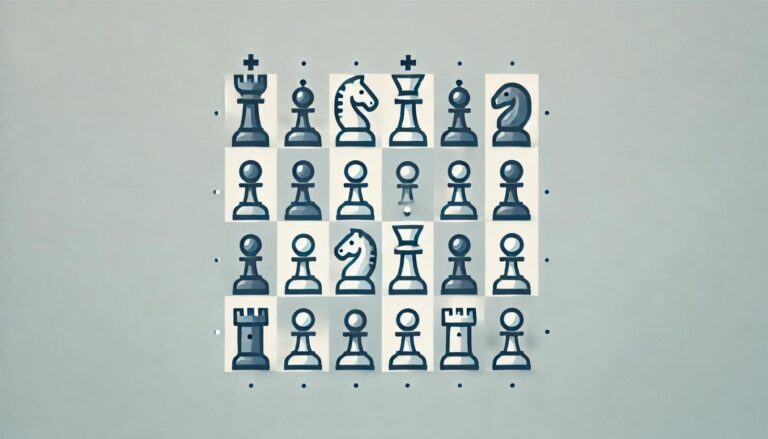Chess is a game of strategy, intellect, and deep concentration, with roots that span over a millennium. Whether you’re a complete novice or an experienced player looking to fine-tune your setup skills, knowing how to properly set up a chess game is essential. A well-arranged board not only ensures a fair and competitive match but also respects the traditions of this ancient game. In this guide, we’ll walk you through the process of setting up a chess game step by step, ensuring that you’re ready to play confidently and correctly.
Understanding the Chessboard
Before diving into the placement of pieces, it’s important to familiarize yourself with the chessboard itself. The board consists of 64 squares, alternating between light and dark colors. Traditionally, the lighter squares are referred to as “white” and the darker ones as “black,” though modern sets may vary in color.
The Square Layout
The chessboard is organized into an 8×8 grid, with columns labeled as files (from “a” to “h”) and rows labeled as ranks (from “1” to “8”). When setting up the board, it’s crucial to remember that the bottom-right corner square must always be a light-colored square. This is an easy-to-remember rule that ensures the board is oriented correctly.
The Importance of Orientation
If the board is oriented incorrectly, the entire setup of pieces will be flawed. Double-check the bottom-right square, ensuring it’s light-colored before placing any pieces on the board. The correct orientation sets the foundation for a legitimate game of chess.
Placing the Pieces on the Board
Once your board is correctly oriented, you can begin placing the pieces. Both players start with 16 pieces: one king, one queen, two rooks, two knights, two bishops, and eight pawns. Each type of piece has a specific starting position.
Step 1: Positioning the Rooks
The rooks, often referred to as castles, are the first pieces to be placed on the board. Each player places their rooks on the two outermost squares of the first rank. For white, the rooks go on a1 and h1; for black, they go on a8 and h8.
Step 2: Setting the Knights
Next, place the knights next to the rooks. Knights are known for their unique L-shaped movement and should be placed on b1 and g1 for white, and b8 and g8 for black.
Step 3: Placing the Bishops
The bishops are positioned next to the knights, occupying the c1 and f1 squares for white, and c8 and f8 squares for black. Bishops move diagonally, so having one on a light square and one on a dark square is essential.
Step 4: Positioning the King and Queen
One of the most critical steps in setting up a chessboard is placing the king and queen. The queen always starts on the square that matches her color: the white queen on the white square (d1) and the black queen on the black square (d8). The king then takes the remaining square next to the queen. For white, the king goes on e1, and for black, the king goes on e8.
Step 5: Placing the Pawns
Finally, place the pawns on the second rank. White pawns go on the a2 through h2 squares, while black pawns go on the a7 through h7 squares. Pawns form the front line of defense and are critical to controlling the early part of the game.
Double-Checking Your Setup
Before starting your game, it’s always a good idea to double-check the setup. Ensure that all pieces are in their correct starting positions and that the board is properly oriented with the light square at the bottom-right corner. This quick check can prevent common beginner mistakes and ensure a smooth start to your game.
Verifying Piece Placement
- Rooks on a1, h1, a8, and h8
- Knights on b1, g1, b8, and g8
- Bishops on c1, f1, c8, and f8
- Queens on d1 (white) and d8 (black)
- Kings on e1 (white) and e8 (black)
- Pawns on the second rank for both players
Ensuring Proper Board Orientation
Remember the golden rule: the bottom-right square must be light-colored. This ensures that all pieces are on the correct squares relative to one another.
Understanding the Significance of the Setup
Setting up a chess game correctly is more than just placing pieces on a board; it’s a nod to the game’s rich history and tradition. Every aspect of the setup has been standardized over centuries to create a fair and balanced starting point for both players. Understanding and respecting this setup is the first step toward becoming a serious chess player.
The Role of Setup in Strategy
The initial setup of a chess game lays the groundwork for the strategies that will unfold. Each piece has a defined role and movement capability, and starting them in their correct positions ensures that the game progresses as intended. A well-organized setup allows players to focus on strategy and tactics, rather than correcting errors.
Teaching New Players
For those teaching chess to beginners, emphasizing the importance of the setup is crucial. A proper setup not only teaches the fundamentals but also instills respect for the game. Beginners who learn to set up the board correctly from the start are less likely to develop bad habits that could hinder their progress.
Common Mistakes to Avoid
Even experienced players can sometimes make mistakes when setting up a chess game. Here are some common pitfalls to watch out for:
Incorrect Board Orientation
One of the most common mistakes is having the board oriented incorrectly, with the dark square in the bottom-right corner. This mistake can throw off the entire setup, leading to confusion during the game.
Misplacing the King and Queen
Another frequent error is switching the positions of the king and queen. Remember, the queen always starts on her matching color, while the king takes the remaining square. Mixing these up can disrupt the game’s flow and strategy.
Overlooking Piece Placement
Sometimes players forget to place all the pieces or accidentally double up on a piece’s starting square. This can easily be avoided by taking a moment to double-check the setup before starting the game.
Final Thoughts on Setting Up a Chess Game
Setting up a chess game is a fundamental skill that every player, regardless of experience level, should master. It’s the first step in engaging with one of the most intellectually stimulating games ever created. By following the steps outlined in this guide, you’ll ensure that every game starts on the right foot, with all pieces in their proper places and the board correctly oriented.
Whether you’re playing casually with friends or preparing for a competitive match, taking the time to set up the board properly shows respect for the game and your opponent. It’s a simple but crucial part of chess that reflects the discipline, strategy, and tradition that make the game so enduringly popular.
Now that your board is set up, it’s time to focus on your opening moves and strategy. Good luck, and enjoy the game!



